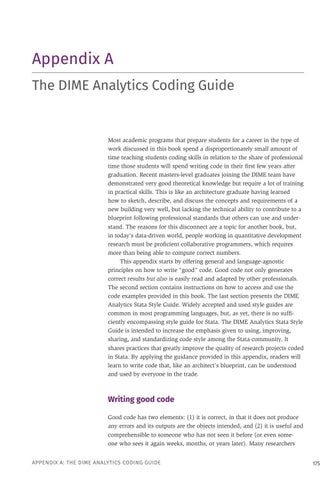Appendix A The DIME Analytics Coding Guide
Most academic programs that prepare students for a career in the type of work discussed in this book spend a disproportionately small amount of time teaching students coding skills in relation to the share of professional time those students will spend writing code in their first few years after graduation. Recent masters-level graduates joining the DIME team have demonstrated very good theoretical knowledge but require a lot of training in practical skills. This is like an architecture graduate having learned how to sketch, describe, and discuss the concepts and requirements of a new building very well, but lacking the technical ability to contribute to a blueprint following professional standards that others can use and understand. The reasons for this disconnect are a topic for another book, but, in today’s data-driven world, people working in quantitative development research must be proficient collaborative programmers, which requires more than being able to compute correct numbers. This appendix starts by offering general and language-agnostic principles on how to write “good” code. Good code not only generates correct results but also is easily read and adapted by other professionals. The second section contains instructions on how to access and use the code examples provided in this book. The last section presents the DIME Analytics Stata Style Guide. Widely accepted and used style guides are common in most programming languages, but, as yet, there is no sufficiently encompassing style guide for Stata. The DIME Analytics Stata Style Guide is intended to increase the emphasis given to using, improving, sharing, and standardizing code style among the Stata community. It shares practices that greatly improve the quality of research projects coded in Stata. By applying the guidance provided in this appendix, readers will learn to write code that, like an architect’s blueprint, can be understood and used by everyone in the trade.
Writing good code Good code has two elements: (1) it is correct, in that it does not produce any errors and its outputs are the objects intended, and (2) it is useful and comprehensible to someone who has not seen it before (or even someone who sees it again weeks, months, or years later). Many researchers APPENDIX A: THE DIME ANALYTICS CODING GUIDE
175





